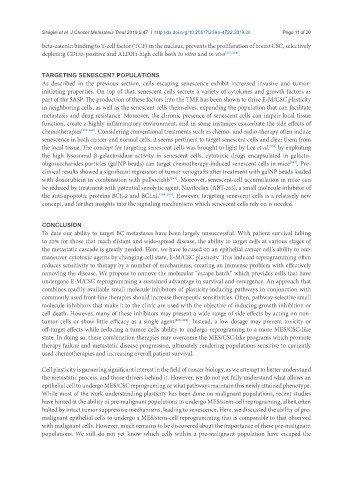Page 346 - Read Online
P. 346
Smigiel et al. J Cancer Metastasis Treat 2019;5:47 I http://dx.doi.org/10.20517/2394-4722.2019.26 Page 11 of 20
beta-catenin binding to T-cell factor (TCF) in the nucleus, prevents the proliferation of breast CSC, selectively
depleting CD133-positive and ALDH1-high cells both in vitro and in vivo [257,258] .
TARGETING SENESCENT POPULATIONS
As described in the previous section, cells escaping senescence exhibit increased invasive and tumor-
initiating properties. On top of that, senescent cells secrete a variety of cytokines and growth factors as
part of the SASP. The production of these factors into the TME has been shown to drive E-M/CSC plasticity
in neighboring cells, as well as the senescent cells themselves, expanding the population that can facilitate
metastasis and drug resistance. Moreover, the chronic presence of senescent cells can impair local tissue
function, create a highly inflammatory environment, and in some instances exacerbate the side effects of
chemotherapies [259,260] . Considering conventional treatments such as chemo- and radio-therapy often induce
senescence in both cancer and normal cells, it seems pertinent to target senescent cells and clear them from
the local tissue. The concept for targeting senescent cells was brought to light by Lee et al. by exploiting
[261]
the high lysosomal β-galactosidase activity in senescent cells, cytotoxic drugs encapsulated in galacto-
oligosaccharides particles (galNP beads) can target chemotherapy-induced senescent cells in mice . Pre-
[262]
clinical results showed a significant regression of tumor xenografts after treatment with galNP beads loaded
with doxorubicin in combination with palbociclib . Moreover, senescent-cell accumulation in mice can
[263]
be reduced by treatment with potential senolytic agent, Navitoclax (ABT-263), a small molecule inhibitor of
the anti-apoptotic proteins BCL-2 and BCLxL [264,265] . However, targeting senescent cells is a relatively new
concept, and further insights into the signaling mechanisms which senescent cells rely on is needed.
CONCLUSION
To date our ability to target BC metastases have been largely unsuccessful. With patient survival falling
to 22% for those that reach distant and wide-spread disease, the ability to target cells at various stages of
the metastatic cascade is greatly needed. Here, we have focused on an epithelial cancer cell’s ability to out-
maneuver cytotoxic agents by changing cell state; E-M/CSC plasticity. This induced reprogramming often
reduces sensitivity to therapy by a number of mechanisms, creating an immense problem with effectively
removing the disease. We propose to remove the molecular “escape hatch” which provides cells that have
undergone E-M/CSC reprogramming a sustained advantage in survival and resurgence. An approach that
combines readily available small molecule inhibitors of plasticity-inducing pathways in conjunction with
commonly used front-line therapies should increase therapeutic sensitivities. Often, pathway-selective small
molecule inhibitors that make it to the clinic are used with the objective of inducing growth inhibition or
cell death. However, many of these inhibitors may present a wide range of side effects by acting on non-
tumor cells or show little efficacy as a single agent [266-268] . Instead, a low dosage may prevent toxicity or
off-target effects while reducing a tumor cells ability to undergo reprograming to a more MES/CSC-like
state. In doing so, these combination therapies may overcome the MES/CSC-like programs which promote
therapy failure and metastatic disease progression, ultimately rendering populations sensitive to currently
used chemotherapies and increasing overall patient survival.
Cell plasticity is garnering significant interest in the field of cancer biology, as we attempt to better understand
the metastatic process, and those drivers behind it. However, we do not yet fully understand what allows an
epithelial cell to undergo MES/CSC reprograming or what pathways maintain this newly attained phenotype.
While most of the work understanding plasticity has been done on malignant populations, recent studies
have hinted at the ability of pre-malignant populations to undergo MES/stem-cell reprograming, albeit often
halted by intact tumor suppressive mechanisms, leading to senescence. Here, we discussed the ability of pre-
malignant epithelial cells to undergo a MES/stem-cell reprogramming that is comparable to that observed
with malignant cells. However, much remains to be discovered about the importance of these pre-malignant
populations. We still do not yet know which cells within a pre-malignant population have escaped the

